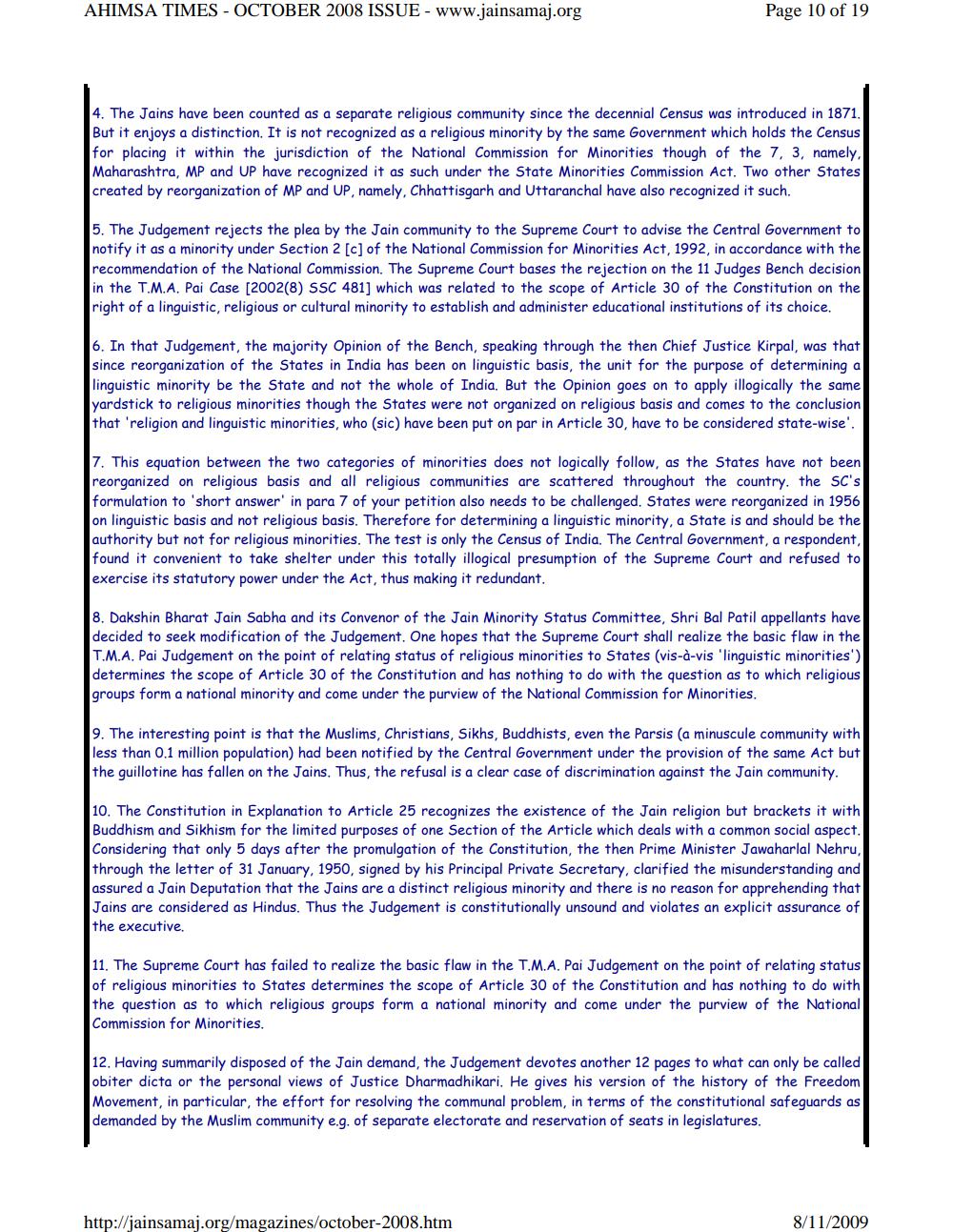________________
AHIMSA TIMES - OCTOBER 2008 ISSUE - www.jainsamaj.org
Page 10 of 19
4. The Jains have been counted as a separate religious community since the decennial Census was introduced in 1871. But it enjoys a distinction. It is not recognized as a religious minority by the same Government which holds the Census for placing it within the jurisdiction of the National Commission for Minorities though of the 7, 3, namely, Maharashtra, MP and UP have recognized it as such under the State Minorities Commission Act. Two other States created by reorganization of MP and UP, namely, Chhattisgarh and Uttaranchal have also recognized it such.
5. The Judgement rejects the plea by the Jain community to the Supreme Court to advise the Central Government to notify it as a minority under Section 2 [c] of the National Commission for Minorities Act, 1992, in accordance with the recommendation of the National Commission. The Supreme Court bases the rejection on the 11 Judges Bench decision in the T.M.A. Pai Case [2002(8) SSC 481] which was related to the scope of Article 30 of the Constitution on the right of a linguistic, religious or cultural minority to establish and administer educational institutions of its choice.
6. In that Judgement, the majority Opinion of the Bench, speaking through the then Chief Justice Kirpal, was that since reorganization of the States in India has been on linguistic basis, the unit for the purpose of determining a linguistic minority be the State and not the whole of India. But the Opinion goes on to apply illogically the same yardstick to religious minorities though the States were not organized on religious basis and comes to the conclusion that 'religion and linguistic minorities, who (sic) have been put on par in Article 30, have to be considered state-wise'.
7. This equation between the two categories of minorities does not logically follow, as the States have not been reorganized on religious basis and all religious communities are scattered throughout the country. the SC's formulation to 'short answer' in para 7 of your petition also needs to be challenged. States were reorganized in 1956 on linguistic basis and not religious basis. Therefore for determining a linguistic minority, a State is and should be the authority but not for religious minorities. The test is only the Census of India. The Central Government, a respondent, found it convenient to take shelter under this totally illogical presumption of the Supreme Court and refused to exercise its statutory power under the Act, thus making it redundant.
8. Dakshin Bharat Jain Sabha and its Convenor of the Jain Minority Status Committee, Shri Bal Patil appellants have decided to seek modification of the Judgement. One hopes that the Supreme Court shall realize the basic flaw in the T.M.A. Pai Judgement on the point of relating status of religious minorities to States (vis-à-vis 'linguistic minorities') determines the scope of Article 30 of the Constitution and has nothing to do with the question as to which religious groups form a national minority and come under the purview of the National Commission for Minorities.
9. The interesting point is that the Muslims, Christians, Sikhs, Buddhists, even the Parsis (a minuscule community with less than 0.1 million population) had been notified by the Central Government under the provision of the same Act but the guillotine has fallen on the Jains. Thus, the refusal is a clear case of discrimination against the Jain community.
10. The Constitution in Explanation to Article 25 recognizes the existence of the Jain religion but brackets it with Buddhism and Sikhism for the limited purposes of one Section of the Article which deals with a common social aspect. Considering that only 5 days after the promulgation of the Constitution, the then Prime Minister Jawaharlal Nehru, through the letter of 31 January, 1950, signed by his Principal Private Secretary, clarified the misunderstanding and assured a Jain Deputation that the Jains are a distinct religious minority and there is no reason for apprehending that Jains are considered as Hindus. Thus the Judgement is constitutionally unsound and violates an explicit assurance of the executive.
11. The Supreme Court has failed to realize the basic flaw in the T.M.A. Pai Judgement on the point of relating status of religious minorities to States determines the scope of Article 30 of the Constitution and has nothing to do with the question as to which religious groups form a national minority and come under the purview of the National Commission for Minorities.
12. Having summarily disposed of the Jain demand, the Judgement devotes another 12 pages to what can only be called obiter dicta or the personal views of Justice Dharmadhikari. He gives his version of the history of the Freedom Movement, in particular, the effort for resolving the communal problem, in terms of the constitutional safeguards as demanded by the Muslim community e.g. of separate electorate and reservation of seats in legislatures.
http://jainsamaj.org/magazines/october-2008.htm.
8/11/2009




